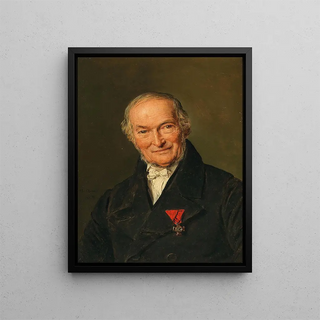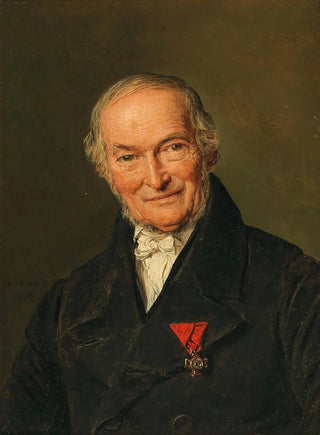Art print | Portrait Franz Benoit - Ferdinand Georg Waldmüller


View from behind

Frame (optional)
Art print Portrait Franz Benoit - Ferdinand Georg Waldmüller – Engaging Introduction
In the captivating world of art, some works transcend the mere frame to become witnesses of human stories, reflections of the soul, and echoes of bygone eras. The "Portrait of Franz Benoit" by Ferdinand Georg Waldmüller perfectly fits this tradition. Created in the 19th century, this painting is much more than a simple depiction of a man; it is an open window into Austrian society of its time, a frozen moment where art and life intersect. Through the penetrating gaze of Franz Benoit, the viewer is invited to explore the subtleties of his character and the nuances of his existence. Waldmüller, with his unparalleled talent, manages to capture not only the physical appearance of his subject but also his essence, creating a work that still resonates today.
Style and uniqueness of the work
Waldmüller’s style is distinguished by a realistic approach that harmoniously blends with romantic sensitivity. In the "Portrait of Franz Benoit," every detail is carefully crafted, from the texture of the clothing to the subtle expressions on the face. The artist uses light masterfully, playing with shadows and reflections to bring his subject to life. The chosen color palette, both rich and delicate, enhances the emotional intensity of the piece. Waldmüller does not merely reproduce a face; he tells a story, that of a man, but also that of an era. The composition, balanced and harmonious, draws the eye and encourages contemplation. Every element, every brushstroke, contributes to creating a unique atmosphere where time seems suspended.
The artist and his influence
Ferdinand Georg Waldmüller is a prominent figure in 19th-century Austrian art, whose influence extends well beyond his era. Born in 1793, he evolved within a rapidly transforming artistic context, between Romanticism and Realism. Waldmüller was able to capture the aspirations and struggles of his time, making him a keen observer of daily life and the customs of his era. His

Matte finish

View from behind

Frame (optional)
Art print Portrait Franz Benoit - Ferdinand Georg Waldmüller – Engaging Introduction
In the captivating world of art, some works transcend the mere frame to become witnesses of human stories, reflections of the soul, and echoes of bygone eras. The "Portrait of Franz Benoit" by Ferdinand Georg Waldmüller perfectly fits this tradition. Created in the 19th century, this painting is much more than a simple depiction of a man; it is an open window into Austrian society of its time, a frozen moment where art and life intersect. Through the penetrating gaze of Franz Benoit, the viewer is invited to explore the subtleties of his character and the nuances of his existence. Waldmüller, with his unparalleled talent, manages to capture not only the physical appearance of his subject but also his essence, creating a work that still resonates today.
Style and uniqueness of the work
Waldmüller’s style is distinguished by a realistic approach that harmoniously blends with romantic sensitivity. In the "Portrait of Franz Benoit," every detail is carefully crafted, from the texture of the clothing to the subtle expressions on the face. The artist uses light masterfully, playing with shadows and reflections to bring his subject to life. The chosen color palette, both rich and delicate, enhances the emotional intensity of the piece. Waldmüller does not merely reproduce a face; he tells a story, that of a man, but also that of an era. The composition, balanced and harmonious, draws the eye and encourages contemplation. Every element, every brushstroke, contributes to creating a unique atmosphere where time seems suspended.
The artist and his influence
Ferdinand Georg Waldmüller is a prominent figure in 19th-century Austrian art, whose influence extends well beyond his era. Born in 1793, he evolved within a rapidly transforming artistic context, between Romanticism and Realism. Waldmüller was able to capture the aspirations and struggles of his time, making him a keen observer of daily life and the customs of his era. His






